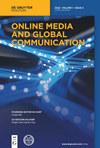媒体曝光和风险感知作为参与新冠肺炎预防行为的预测因素:将计划行为理论扩展到两种文化
引用次数: 2
摘要
摘要目的通过基于计划行为理论(TPB)的模型检验,探讨影响新冠肺炎预防行为绩效的心理和社会因素。我们的模型以媒体曝光和社交网站(SNS)参与为特征,我们在两个截然不同的文化中对COVID-19的态度进行了测试:美国和日本。方法采用在线调查的方法,每种培养物采集样本300份。参与是自愿的,通过众包平台获得金钱补偿。总体而言,结果表明我们的TPB模型在每种文化中都很适合。在两种文化中,媒体暴露是风险感知的主要预测因素,而社交网络的参与仅预测日本人的预防行为意愿,而个人卫生也被发现是日本人保护行为的重要预测因素。虽然影响预防行为的变量存在差异,但总体而言,我们提出的模型在两种文化中都是稳健的。以日本和美国为代表的“宽松文化”和“严格文化”在预防新冠肺炎的态度上存在差异。本文章由计算机程序翻译,如有差异,请以英文原文为准。
Media Exposure and Risk Perception as Predictors of Engagement in COVID-19 Preventive Behaviors: Extending the Theory of Planned Behavior Across Two Cultures
Abstract Purpose This study examined the psychological and social factors that affect the performance of preventive behaviors toward COVID-19, by testing a model based on the theory of planned behavior (TPB). Our model featured media exposure and social networking site (SNS) involvement, and we tested it in two highly contrasted cultures regarding COVID-19 attitudes: U.S. and Japan. Method An online survey collected 300 samples for each culture. Participation was voluntary, for monetary compensation through crowd-sourcing platforms. Findings Overall, the results showed a good fit of our TPB model in each culture. Media exposure was a major predictor of risk perception in both cultures, while engagement in SNS predicted intention to perform preventive behavior for the Japanese only, and personal hygiene was found to be a significant predictor of protective behavior once again only for the Japanese. Implications and Value While there were differences in the variables affecting preventive behaviors, overall, our proposed model proved to be robust across both cultures. Implications were made on differences between tight and loose cultures, as represented by Japan and the US, regarding COVID-19 preventive attitudes.
求助全文
通过发布文献求助,成功后即可免费获取论文全文。
去求助
来源期刊

Online Media and Global Communication
Communication, Media Studies, Internet Studies, International Studies, International Relations-
自引率
0.00%
发文量
0
期刊介绍:
Online Media and Global Communication (OMGC) is a new venue for high quality articles on theories and methods about the role of online media in global communication. This journal is sponsored by the Center for Global Public Opinion Research of China and School of Journalism and Communication, Shanghai International Studies University, China. It is published solely online in English. The journal aims to serve as an academic bridge in the research of online media and global communication between the dominating English-speaking world and the non-English speaking world that has remained mostly invisible due to language barriers. Through its structured abstracts for all research articles and uniform keyword system in the United Nations’ official six languages plus Japanese and German (Arabic, Chinese, English, French, Russian, Spanish, Japanese, and German), the journal provides a highly accessible platform to users worldwide. Its unique dual track single-blind and double-blind review system facilitates manuscript reviews with different levels of author identities. OMGC publishes review essays on the state-of-the-art in online media and global communication research in different countries and regions, original research papers on topics related online media and global communication and translated articles from non-English speaking Global South. It strives to be a leading platform for scientific exchange in online media and global communication.
For events and more, consider following us on Twitter at https://twitter.com/OMGCJOURNAL.
Topics
OMGC publishes high quality, innovative and original research on global communication especially in the use of global online media platforms such as Facebook, TikTok, YouTube, Twitter, Instagram, WhatsApp, Weibo, WeChat, Wikipedia, web sites, blogs, etc. This journal will address the contemporary concerns about the effects and operations of global digital media platforms on international relations, international public opinion, fake news and propaganda dissemination, diaspora communication, consumer behavior as well as the balance of voices in the world. Comparative research across countries are particularly welcome. Empirical research is preferred over conceptual papers.
Article Formats
In addition to the standard research article format, the Journal includes the following formats:
● One translation paper selected from Non-English Journals that with high quality as “Gems from the Global South” per issue
● One review essay on current state of research in online media and global communication in a country or region
 求助内容:
求助内容: 应助结果提醒方式:
应助结果提醒方式:


